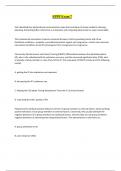Exam (elaborations)
EPPP Exam 7
- Course
- Institution
EPPP Exam 7 Satir identified four dysfunctional communication styles that contribute to family problems: blaming, placating, distracting (often referred to as irrelevant), and computing (also known as super-reasonable). The fundamental assumption of person-centered therapy is that by provid...
[Show more]



